Visual cortex
| Visual cortex | |
|---|---|
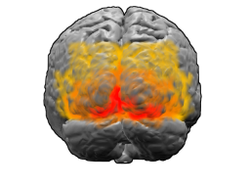 View of the brain from behind. Red = Brodmann area 17 (primary visual cortex); orange = area 18; yellow = area 19 | |
 Brain shown from the side, facing left. Above: view from outside, below: cut through the middle. Orange = Brodmann area 17 (primary visual cortex) | |
| Details | |
| Identifiers | |
| Latin | cortex visualis |
| MeSH | D014793 |
| NeuroLex ID | nlx_143552 |
| FMA | 242644 |
| Anatomical terms of neuroanatomy | |
The visual cortex of the brain is the area of the cerebral cortex that processes visual information. It is located in the occipital lobe. Sensory input originating from the eyes travels through the lateral geniculate nucleus in the thalamus and then reaches the visual cortex. The area of the visual cortex that receives the sensory input from the lateral geniculate nucleus is the primary visual cortex, also known as visual area 1 (V1), Brodmann area 17, or the striate cortex. The extrastriate areas consist of visual areas 2, 3, 4, and 5 (also known as V2, V3, V4, and V5, or Brodmann area 18 and all Brodmann area 19).[1]
Both hemispheres of the brain include a visual cortex; the visual cortex in the left hemisphere receives signals from the right visual field, and the visual cortex in the right hemisphere receives signals from the left visual field.
Introduction
The primary visual cortex (V1) is located in and around the
Neurons in the visual cortex fire action potentials when visual stimuli appear within their receptive field. By definition, the receptive field is the region within the entire visual field that elicits an action potential. But, for any given neuron, it may respond best to a subset of stimuli within its receptive field. This property is called neuronal tuning. In the earlier visual areas, neurons have simpler tuning. For example, a neuron in V1 may fire to any vertical stimulus in its receptive field. In the higher visual areas, neurons have complex tuning. For example, in the inferior temporal cortex (IT), a neuron may fire only when a certain face appears in its receptive field.
Furthermore, the arrangement of receptive fields in V1 is retinotopic, meaning neighboring cells in V1 have receptive fields that correspond to adjacent portions of the visual field. This spatial organization allows for a systematic representation of the visual world within V1. Additionally, recent studies have delved into the role of contextual modulation in V1, where the perception of a stimulus is influenced not only by the stimulus itself but also by the surrounding context, highlighting the intricate processing capabilities of V1 in shaping our visual experiences.[2]
The visual cortex receives its blood supply primarily from the
The size of V1, V2, and V3 can vary three-fold, a difference that is partially inherited.[3]
Psychological model of the neural processing of visual information
Ventral-dorsal model
V1 transmits information to two primary pathways, called the ventral stream and the dorsal stream.[4]
- The inferior temporal cortex (IT cortex). The ventral stream, sometimes called the "What Pathway", is associated with form recognition and object representation. It is also associated with storage of long-term memory.
- The dorsomedial area (DM/V6) and medial temporal area (MT/V5) and to the posterior parietal cortex. The dorsal stream, sometimes called the "Where Pathway" or "How Pathway", is associated with motion, representation of object locations, and control of the eyes and arms, especially when visual information is used to guide saccadesor reaching.
The what vs. where account of the ventral/dorsal pathways was first described by Ungerleider and Mishkin.[5]
More recently, Goodale and Milner extended these ideas and suggested that the ventral stream is critical for visual perception whereas the dorsal stream mediates the visual control of skilled actions.[6] It has been shown that visual illusions such as the Ebbinghaus illusion distort judgements of a perceptual nature, but when the subject responds with an action, such as grasping, no distortion occurs.[7]
Work such as the one from Franz et al.[8] suggests that both the action and perception systems are equally fooled by such illusions. Other studies, however, provide strong support for the idea that skilled actions such as grasping are not affected by pictorial illusions[9][10] and suggest that the action/perception dissociation is a useful way to characterize the functional division of labor between the dorsal and ventral visual pathways in the cerebral cortex.[11]
Primary visual cortex (V1)
This section needs additional citations for verification. (November 2016) |
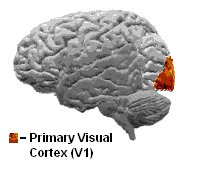
The primary visual cortex is the most studied visual area in the brain. In mammals, it is located in the posterior pole of the occipital lobe and is the simplest, earliest cortical visual area. It is highly specialized for processing information about static and moving objects and is excellent in pattern recognition. Moreover, V1 is characterized by a laminar organization, with six distinct layers, each playing a unique role in visual processing. Neurons in the superficial layers (II and III) are often involved in local processing and communication within the cortex, while neurons in the deeper layers (V and VI) often send information to other brain regions involved in higher-order visual processing and decision-making.
Research on V1 has also revealed the presence of orientation-selective cells, which respond preferentially to stimuli with a specific orientation, contributing to the perception of edges and contours. The discovery of these orientation-selective cells has been fundamental in shaping our understanding of how V1 processes visual information.
Furthermore, V1 exhibits plasticity, allowing it to undergo functional and structural changes in response to sensory experience. Studies have demonstrated that sensory deprivation or exposure to enriched environments can lead to alterations in the organization and responsiveness of V1 neurons, highlighting the dynamic nature of this critical visual processing hub.[12][clarification needed]
The primary visual cortex, which is defined by its function or stage in the visual system, is approximately equivalent to the striate cortex, also known as Brodmann area 17, which is defined by its anatomical location. The name "striate cortex" is derived from the line of Gennari, a distinctive stripe visible to the naked eye.
It's worth noting that Brodmann area 17 is just one subdivision of the broader Brodmann areas, which are regions of the cerebral cortex defined based on cytoarchitectural differences. In the case of the striate cortex, the line of Gennari corresponds to a band rich in myelinated nerve fibers, providing a clear marker for the primary visual processing region.
Additionally, the functional significance of the striate cortex extends beyond its role as the primary visual cortex. It serves as a crucial hub for the initial processing of visual information, such as the analysis of basic features like orientation, spatial frequency, and color. The integration of these features in the striate cortex forms the foundation for more complex visual processing carried out in higher-order visual areas. Recent neuroimaging studies have contributed to a deeper understanding of the dynamic interactions within the striate cortex and its connections with other visual and non-visual brain regions, shedding light on the intricate neural circuits that underlie visual perception.
The primary visual cortex is divided into six functionally distinct layers, labeled 1 to 6. Layer 4, which receives most visual input from the lateral geniculate nucleus (LGN), is further divided into 4 layers, labelled 4A, 4B, 4Cα, and 4Cβ. Sublamina 4Cα receives mostly magnocellular input from the LGN, while layer 4Cβ receives input from parvocellular pathways.[14]
The average number of neurons in the adult human primary visual cortex in each hemisphere has been estimated at 140 million.[15]
Function
This article may be too technical for most readers to understand. (September 2016) |
The initial stage of visual processing within the cortex, known as V1, plays a fundamental role in shaping our perception of the visual world. V1 possesses a meticulously defined map, referred to as the retinotopic map, which intricately organizes spatial information from the visual field. In humans, the upper bank of the calcarine sulcus in the occipital lobe robustly responds to the lower half of the visual field, while the lower bank responds to the upper half. This retinotopic mapping conceptually represents a projection of the visual image from the retina to V1.
The importance of this retinotopic organization lies in its ability to preserve spatial relationships present in the external environment. Neighboring neurons in V1 exhibit responses to adjacent portions of the visual field, creating a systematic representation of the visual scene. This mapping extends both vertically and horizontally, ensuring the conservation of both horizontal and vertical relationships within the visual input.
Moreover, the retinotopic map demonstrates a remarkable degree of plasticity, adapting to alterations in visual experience. Studies have revealed that changes in sensory input, such as those induced by visual training or deprivation, can lead to shifts in the retinotopic map. This adaptability underscores the brain's capacity to reorganize in response to varying environmental demands, highlighting the dynamic nature of visual processing.
Beyond its spatial processing role, the retinotopic map in V1 establishes intricate connections with other visual areas, forming a network crucial for integrating diverse visual features and constructing a coherent visual percept. This dynamic mapping mechanism is indispensable for our ability to navigate and interpret the visual world effectively.
The correspondence between specific locations in V1 and the subjective visual field is exceptionally precise, even extending to map the blind spots of the retina. Evolutionarily, this correspondence is a fundamental feature found in most animals possessing a V1. In humans and other species with a fovea (cones in the retina), a substantial portion of V1 is mapped to the small central portion of the visual field—a phenomenon termed cortical magnification. This magnification reflects an increased representation and processing capacity devoted to the central visual field, essential for detailed visual acuity and high-resolution processing.
Notably, neurons in V1 have the smallest receptive field size, signifying the highest resolution, among visual cortex microscopic regions. This specialization equips V1 with the ability to capture fine details and nuances in the visual input, emphasizing its pivotal role as a critical hub in early visual processing and contributing significantly to our intricate and nuanced visual perception.[16]
In addition to its role in spatial processing, the retinotopic map in V1 is intricately connected with other visual areas, forming a network that contributes to the integration of various visual features and the construction of a coherent visual percept. This dynamic mapping mechanism is fundamental to our ability to navigate and interpret the visual world effectively.[17] The correspondence between a given location in V1 and in the subjective visual field is very precise: even the blind spots of the retina are mapped into V1. In terms of evolution, this correspondence is very basic and found in most animals that possess a V1. In humans and other animals with a fovea (cones in the retina), a large portion of V1 is mapped to the small, central portion of visual field, a phenomenon known as cortical magnification.[18] Perhaps for the purpose of accurate spatial encoding, neurons in V1 have the smallest receptive field size (that is, the highest resolution) of any visual cortex microscopic regions.
The tuning properties of V1 neurons (what the neurons respond to) differ greatly over time. Early in time (40 ms and further) individual V1 neurons have strong tuning to a small set of stimuli. That is, the neuronal responses can discriminate small changes in visual
Later in time (after 100 ms), neurons in V1 are also sensitive to the more global organisation of the scene (Lamme & Roelfsema, 2000).[19] These response properties probably stem from recurrent feedback processing (the influence of higher-tier cortical areas on lower-tier cortical areas) and lateral connections from pyramidal neurons (Hupe et al. 1998). While feedforward connections are mainly driving, feedback connections are mostly modulatory in their effects (Angelucci et al., 2003; Hupe et al., 2001). Evidence shows that feedback originating in higher-level areas such as V4, IT, or MT, with bigger and more complex receptive fields, can modify and shape V1 responses, accounting for contextual or extra-classical receptive field effects (Guo et al., 2007; Huang et al., 2007; Sillito et al., 2006).
The visual information relayed to V1 is not coded in terms of spatial (or optical) imagery[citation needed] but rather are better described as edge detection.[20] As an example, for an image comprising half side black and half side white, the dividing line between black and white has strongest local contrast (that is, edge detection) and is encoded, while few neurons code the brightness information (black or white per se). As information is further relayed to subsequent visual areas, it is coded as increasingly non-local frequency/phase signals. Note that, at these early stages of cortical visual processing, spatial location of visual information is well preserved amid the local contrast encoding (edge detection).
A theoretical explanation of the computational function of the simple cells in the primary visual cortex has been presented in.[21][22][23] It is described how receptive field shapes similar to those found by the biological receptive field measurements performed by DeAngelis et al.[24][25] can be derived as a consequence of structural properties of the environment in combination with internal consistency requirements to guarantee consistent image representations over multiple spatial and temporal scales. It is also described how the characteristic receptive field shapes, tuned to different scales, orientations and directions in image space, allow the visual system to compute invariant responses under natural image transformations at higher levels in the visual hierarchy.[26][22][23]
In primates, one role of V1 might be to create a saliency map (highlights what is important) from visual inputs to guide the shifts of attention known as gaze shifts.[27]
According to the V1 Saliency Hypothesis, V1 does this by transforming visual inputs to neural firing rates from millions of neurons, such that the visual location signaled by the highest firing neuron is the most salient location to attract gaze shift. V1's outputs are received by the superior colliculus (in the mid-brain), among other locations, which reads out the V1 activities to guide gaze shifts.
Differences in size of V1 also seem to have an effect on the perception of illusions.[28]
V2
| Colour centre | |
|---|---|
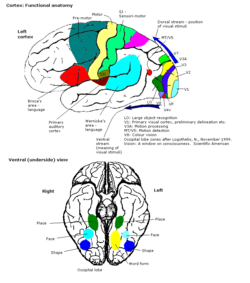 The difference V-regions. More images in Colour centre | |
| Identifiers | |
| MeSH | D014793 |
| NeuroLex ID | nlx_143552 |
| FMA | 242644 |
| Anatomical terminology | |
Visual area V2, or secondary visual cortex, also called prestriate cortex,[29] receives strong feedforward connections from V1 (direct and via the pulvinar) and sends robust connections to V3, V4, and V5. Additionally, it plays a crucial role in the integration and processing of visual information.
The feedforward connections from V1 to V2 contribute to the hierarchical processing of visual stimuli. V2 neurons build upon the basic features detected in V1, extracting more complex visual attributes such as texture, depth, and color. This hierarchical processing is essential for the construction of a more nuanced and detailed representation of the visual scene.
Furthermore, the reciprocal feedback connections from V2 to V1 play a significant role in modulating the activity of V1 neurons. This feedback loop is thought to be involved in processes such as attention, perceptual grouping, and figure-ground segregation. The dynamic interplay between V1 and V2 highlights the intricate nature of information processing within the visual system.
Moreover, V2's connections with subsequent visual areas, including V3, V4, and V5, contribute to the formation of a distributed network for visual processing. These connections enable the integration of different visual features, such as motion and form, across multiple stages of the visual hierarchy.[30]
In terms of anatomy, V2 is split into four quadrants, a
It is argued that the entire ventral visual-to-hippocampal stream is important for visual memory.[36] This theory, unlike the dominant one, predicts that object-recognition memory (ORM) alterations could result from the manipulation in V2, an area that is highly interconnected within the ventral stream of visual cortices. In the monkey brain, this area receives strong feedforward connections from the primary visual cortex (V1) and sends strong projections to other secondary visual cortices (V3, V4, and V5).[37][38] Most of the neurons of this area in primates are tuned to simple visual characteristics such as orientation, spatial frequency, size, color, and shape.[32][39][40] Anatomical studies implicate layer 3 of area V2 in visual-information processing. In contrast to layer 3, layer 6 of the visual cortex is composed of many types of neurons, and their response to visual stimuli is more complex.
In one study, the Layer 6 cells of the V2 cortex were found to play a very important role in the storage of Object Recognition Memory as well as the conversion of short-term object memories into long-term memories.[41]
Third visual cortex, including area V3
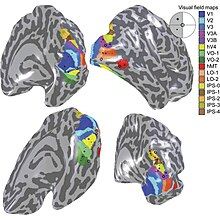
The term third visual complex refers to the region of cortex located immediately in front of V2, which includes the region named visual area V3 in humans. The "complex" nomenclature is justified by the fact that some controversy still exists regarding the exact extent of area V3, with some researchers proposing that the cortex located in front of V2 may include two or three functional subdivisions. For example, David Van Essen and others (1986) have proposed the existence of a "dorsal V3" in the upper part of the cerebral hemisphere, which is distinct from the "ventral V3" (or ventral posterior area, VP) located in the lower part of the brain. Dorsal and ventral V3 have distinct connections with other parts of the brain, appear different in sections stained with a variety of methods, and contain neurons that respond to different combinations of visual stimulus (for example, colour-selective neurons are more common in the ventral V3). Additional subdivisions, including V3A and V3B have also been reported in humans. These subdivisions are located near dorsal V3, but do not adjoin V2.
Dorsal V3 is normally considered to be part of the dorsal stream, receiving inputs from V2 and from the primary visual area and projecting to the posterior
Ventral V3 (VP), has much weaker connections from the primary visual area, and stronger connections with the
V4
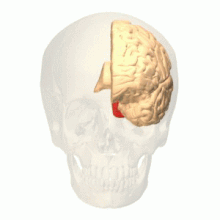

Visual area V4 is one of the visual areas in the
V4 is the third cortical area in the ventral stream, receiving strong feedforward input from V2 and sending strong connections to the PIT. It also receives direct input from V1, especially for central space. In addition, it has weaker connections to V5 and dorsal prelunate gyrus (DP).
V4 is the first area in the
Like V2, V4 is tuned for orientation, spatial frequency, and color. Unlike V2, V4 is tuned for object features of intermediate complexity, like simple geometric shapes, although no one has developed a full parametric description of the tuning space for V4. Visual area V4 is not tuned for complex objects such as faces, as areas in the inferotemporal cortex are.
The firing properties of V4 were first described by
Recent work has shown that V4 exhibits long-term plasticity,[46] encodes stimulus salience, is gated by signals coming from the frontal eye fields,[47] and shows changes in the spatial profile of its receptive fields with attention.[citation needed] In addition, it has recently been shown that activation of area V4 in humans (area V4h) is observed during the perception and retention of the color of objects, but not their shape.[48][49]
Middle temporal visual area (V5)
The middle temporal visual area (MT or V5) is a region of extrastriate visual cortex. In several species of both
Connections
MT is connected to a wide array of cortical and subcortical brain areas. Its input comes from visual cortical areas V1, V2 and dorsal V3 (
A standard view is that V1 provides the "most important" input to MT.[50] Nonetheless, several studies have demonstrated that neurons in MT are capable of responding to visual information, often in a direction-selective manner, even after V1 has been destroyed or inactivated.[56] Moreover, research by Semir Zeki and collaborators has suggested that certain types of visual information may reach MT before it even reaches V1.
MT sends its major output to areas located in the cortex immediately surrounding it, including areas FST, MST, and V4t (middle temporal crescent). Other projections of MT target the eye movement-related areas of the frontal and parietal lobes (frontal eye field and lateral intraparietal area).
Function
The first studies of the
Lesion studies have also supported the role of MT in motion perception and eye movements.[59] Neuropsychological studies of a patient unable to see motion, seeing the world in a series of static 'frames' instead, suggested that V5 in the primate is homologous to MT in the human.[60][61]
However, since neurons in V1 are also tuned to the direction and speed of motion, these early results left open the question of precisely what MT could do that V1 could not. Much work has been carried out on this region, as it appears to integrate local visual motion signals into the global motion of complex objects.[62] For example, lesion to the V5 leads to deficits in perceiving motion and processing of complex stimuli. It contains many neurons selective for the motion of complex visual features (line ends, corners). Microstimulation of a neuron located in the V5 affects the perception of motion. For example, if one finds a neuron with preference for upward motion in a monkey's V5 and stimulates it with an electrode, then the monkey becomes more likely to report 'upward' motion when presented with stimuli containing 'left' and 'right' as well as 'upward' components.[63]
There is still much controversy over the exact form of the computations carried out in area MT[64] and some research suggests that feature motion is in fact already available at lower levels of the visual system such as V1.[65][66]
Functional organization
MT was shown to be organized in direction columns.[67] DeAngelis argued that MT neurons were also organized based on their tuning for binocular disparity.[68]
V6
The dorsomedial area (DM) also known as V6, appears to respond to visual stimuli associated with self-motion
There are similarities between the visual area V5 and V6 of the
For many years, it was considered that DM only existed in
Properties
Neurons in area DM/V6 of night monkeys and common marmosets have unique response properties, including an extremely sharp selectivity for the orientation of visual contours, and preference for long, uninterrupted lines covering large parts of the visual field.[75][76]
However, in comparison with area MT, a much smaller proportion of DM cells shows selectivity for the direction of motion of visual patterns.[77] Another notable difference with area MT is that cells in DM are attuned to low spatial frequency components of an image, and respond poorly to the motion of textured patterns such as a field of random dots.[77] These response properties suggest that DM and MT may work in parallel, with the former analyzing self-motion relative to the environment, and the latter analyzing the motion of individual objects relative to the background.[77]
Recently, an area responsive to wide-angle flow fields has been identified in the human and is thought to be a homologue of macaque area V6.[78]
Pathways
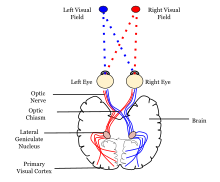
The connections and response properties of cells in DM/ V6 suggest that this area is a key node in a subset of the "
See also
- Cortical area
- Cortical blindness
- Feature integration theory
- List of regions in the human brain
- Retinotopy
- Visual processing
- Complex cell
References
- ^ Mather, George. "The Visual Cortex". School of Life Sciences: University of Sussex. Retrieved 2017-03-06.
- ^ Fişek, Mehmet et al. “Cortico-cortical feedback engages active dendrites in visual cortex.” Nature vol. 617,7962 (2023): 769-776. doi:10.1038/s41586-023-06007-6
- PMID 36180226.
- ISBN 978-3-319-29971-6.
- ISBN 978-0-262-09022-3.
- S2CID 793980.
- S2CID 206111613.
- PMID 16366795.
- S2CID 4314969.
- S2CID 15679825.
- PMID 20691202.
- ^ Coen, Philip et al. “Mouse frontal cortex mediates additive multisensory decisions.” Neuron vol. 111,15 (2023): 2432-2447.e13. doi:10.1016/j.neuron.2023.05.008
- S2CID 53168851.
- S2CID 6478458.
- S2CID 28320951.
- ^ Wu, Fangfang et al. “A Comprehensive Overview of the Role of Visual Cortex Malfunction in Depressive Disorders: Opportunities and Challenges.” Neuroscience bulletin vol. 39,9 (2023): 1426-1438. doi:10.1007/s12264-023-01052-7
- ^ a b Johannes Kepler (1604) Paralipomena to Witelo whereby The Optical Part of Astronomy is Treated (Ad Vitellionem Paralipomena, quibus astronomiae pars optica traditvr, 1604), as cited by A.Mark Smith (2015) From Sight to Light. Kepler modeled the eye as a water-filled glass sphere, and discovered that each point of the scene taken in by the eye projects onto a point on the back of the eye (the retina).
- ^ Barghout, Lauren (1999). On the Differences Between Peripheral and Foveal Pattern Masking (Masters). Berkeley, California: University of California, Berkeley.
- ISBN 978-3-639-70962-9.
- PMID 33269147.
- PMID 24197240.
- ^ PMID 33521348.
- ^ PMID 37398936.
- S2CID 12827601.
- ^ DeAngelis GC, Anzai A (2004). "A modern view of the classical receptive field: linear and non-linear spatio-temporal processing by V1 neurons". In Chalupa LM, Werner JS (eds.). The Visual Neurosciences. Vol. 1. Cambridge: MIT Press. pp. 704–719.
- PMID 23894283.
- ISBN 9780199564668.
- PMID 21131954.
- ^ Gazzaniga; Ivry; Mangun (2002). Cognitive neuroscience.[full citation needed]
- ^ Taylor, Katherine. and Jeanette Rodriguez. “Visual Discrimination.” StatPearls, StatPearls Publishing, 19 September 2022
- PMID 6539501.
- ^ S2CID 6796448.
- S2CID 10269181.
- PMID 15996555.
- PMID 18753321.
- S2CID 13271331.
- S2CID 8500842.
- PMID 9087820.
- PMID 10684908.
- S2CID 6428310.
- S2CID 23990759.
- S2CID 24081674.
- S2CID 25982910.
- PMID 21467155.
- PMID 4023713.
- PMID 24285880.
- S2CID 4405385.
- ISBN 978-3-030-71636-3.
- S2CID 239648133.
- ^ PMID 16022593.
- PMID 1822724.
- S2CID 1876622.
- S2CID 13419990.
- PMID 20179789.
- S2CID 21562682.
- PMID 2723765.
- PMID 5002708..
- S2CID 8708245.
- PMID 3585468.
- PMID 2723744.
- PMID 1992012.
- ^ Movshon, J.A., Adelson, E.H., Gizzi, M.S., & Newsome, W.T. (1985). The analysis of moving visual patterns. In: C. Chagas, R. Gattass, & C. Gross (Eds.), Pattern recognition mechanisms (pp. 117–151), Rome: Vatican Press.
- S2CID 52820462.
- S2CID 45196189.
- S2CID 540146.
- PMID 12575958.
- PMID 6520628.
- PMID 9952417.
- PMID 20034998.
- ^ PMID 16870741.
- S2CID 22980932.
- PMID 23335889.
- S2CID 15020868. Archived from the original(PDF) on 2017-08-08. Retrieved 2018-09-14.
- ^ S2CID 1821863.
- S2CID 9865958.
- PMID 15858163.
- ^ a b c Denis Ducreux. "Calcarine (Visual) Cortex". Connectopedia Knowledge Database. Archived from the original on 2018-01-20. Retrieved 2018-01-25.
{{cite web}}: CS1 maint: unfit URL (link) - PMID 19502476.
- ^ PMID 20053915.
- S2CID 207811473.
External links
- "The Primary Visual Cortex by Matthew Schmolesky". University of Utah. Archived from the original on 2004-12-29.
- "Architecture of the Visual Cortex by David Hubel". Harvard University. Archived from the original on 2017-03-01.
- ancil-415 at NeuroNames – striate area 17
- ancil-699 at NeuroNames – Brodmann area 17 in guenon
- Stained brain slice images which include the "visual%20cortex" at the BrainMaps project
- Simulator for computational modeling of visual cortex maps at topographica.org
